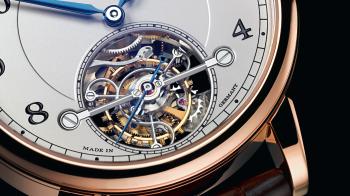A. Lange & Söhne is a Manufacture that takes its time. It waited until 2014 before integrating a first tourbillon into its iconic 1815 collection, despite having mastered the complication for decades. Why did it take so long?
It’s often the case in watchmaking that the most obvious developments arrive last of all, and those relating to the tourbillon are no exception. For two centuries, watchmakers had been striving to make it the ultimate complication, guaranteeing the greatest possible accuracy; but nobody in any major Manufacture had ever come up with the idea of stopping it to reset the time – to the nearest second.
An old problem
The device in question, which is common on three-hand watches, is known as the stop-seconds mechanism. As its name suggests, it’s used to stop the seconds hand briefly when resetting the time. Put another way, it serves to set the watch to the exact time, to the nearest minute and second. That might be easy enough to achieve for a central seconds hand, but it had never been done on a tourbillon, even though the latter also indicates seconds in most cases. In 2014, A. Lange & Söhne plugged this gap – but it didn’t do so simply by temporarily halting the seconds indicated by its tourbillon. It went further: when the crown is pulled, the balance inside the tourbillon cage stops and the seconds hand returns to zero, all in an instant. That makes it easy to set the time using another watch or a time signal as a reference.

Two steps foward
This new development was achieved in two stages. In 1997, A. Lange & Söhne presented its patented Zero-Reset, which instantly returns the halted seconds hand to a vertical position. The mechanism comprises a rod linked to a heart-shaped cam connected to the seconds hand, in similar fashion to the reset cams on a chronograph. The principle was first used in the Langematik Sax-0-Mat. In 2008, in the Cabaret Tourbillon, A. Lange & Söhne watchmakers solved the other half of the problem: temporarily stopping the tourbillon. The manufacture succeeded in doing this by directly braking the balance inside the rotating cage whilst avoiding its pillars. In A. Lange & Söhne’s solution, pulling the crown triggers a complex lever mechanism that lowers a V-shaped spring onto the balance-wheel rim. One or both arms of the V immediately bring the wheel to a standstill.

In 2014, A. Lange & Söhne closed the loop by putting the two developments together in its 1815 Tourbillon, combining the system for immobilising the tourbillon seconds hand counter with its zero-reset mechanism. This was a world first. When the crown is pulled, in addition to the seconds hand being halted, it immediately returns to zero, allowing the minutes hand to be precisely aligned with a minutes marking, so that the watch can be reset with the hours, minutes, and seconds all perfectly positioned.
Not man of them around
Always very fussy about the proportions of its compositions, A. Lange & Söhne presented its Tourbillon 1815 in the original 39,5mm diameter of the collection to which it belongs, as it had done for its ‘Pour le Mérite’ Tourbillon in 1994. In the 1815 Tourbillon, the dial window at 6 o’clock revealing the noble complication also provides a clear view of the top of the Zero-Reset lever which strikes the heart-shaped cam installed beneath the seconds hand. Two versions of this model were presented in 2014. These were followed by a ‘Handwerkskunst’ edition featuring a frosted, rhodium-plated rose gold dial, (2015) and then an enamel dial version (2018). The timepiece is still in the collection today.

*This year GMT Magazine and WorldTempus have embarked on the ambitious project of summarising the last 20 years of the Tourbillon in The Millennium Watch Book - Tourbillons, a big, beautifully laid out coffee table book. This article is an extract. The Millennium Watch Book - Tourbillons is available on www.the-watch-book.com, in French and English.






